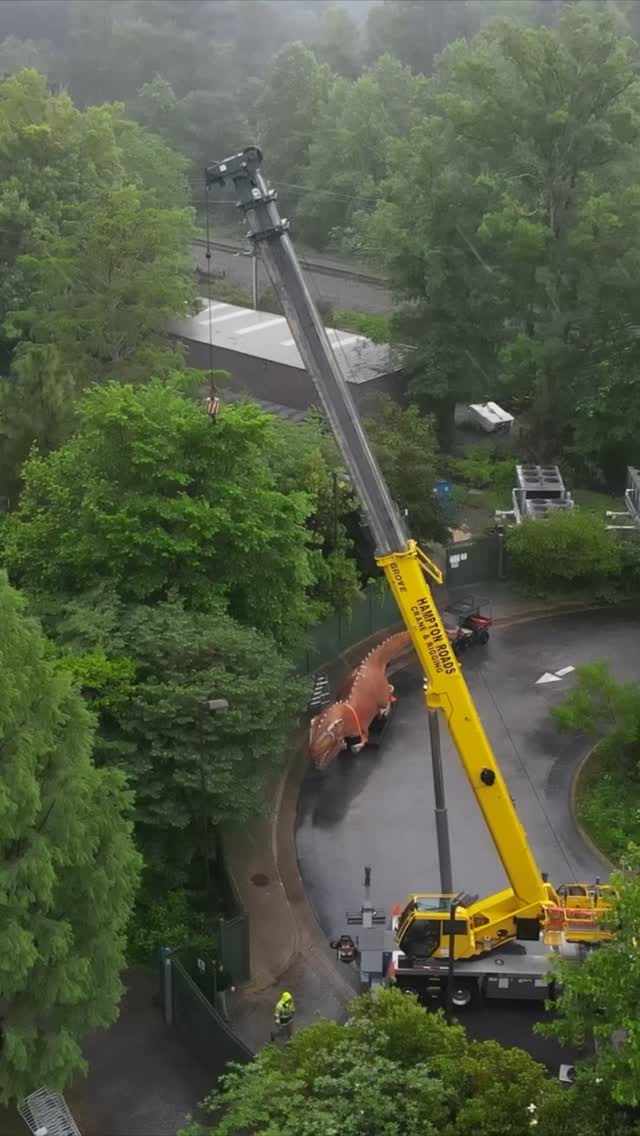- The arrival and display of the Giganotosaurus dinosaur at the Virginia Living Museum.
- The significance of Giganotosaurus in paleontological research and its characteristics.
- The logistics and effort involved in transporting and assembling large dinosaur replicas.
- The role of museums in education and conservation through exhibits like Dino Summer.
- The broader context of wildlife conservation and the public’s fascination with dinosaurs.
The arrival of a life-sized Giganotosaurus model at the Virginia Living Museum marks an exciting moment for visitors and staff alike. This impressive 40-foot, three-ton dinosaur replica is the centerpiece of the Dino Summer exhibition. Despite challenging weather, dedicated volunteers, museum staff, and media personnel gathered to witness Hampton Roads Crane & Rigging carefully place the massive dinosaur on display. This event is more than just an exhibition; it represents a significant effort in education, conservation, and paleontological appreciation.
Giganotosaurus, a name meaning “giant southern lizard,” was one of the largest carnivorous dinosaurs. First discovered in Argentina, it roamed the Earth around 98 million years ago during the Late Cretaceous period. Known for its massive size, Giganotosaurus measured up to 40 feet in length and weighed approximately eight tons in life. Unlike the more famous Tyrannosaurus Rex, Giganotosaurus featured a longer skull and a lighter build, allowing it to be a swift and formidable predator. Its arrival at the museum invites visitors to explore the fascinating details of its existence, from diet to habitat.
Bringing such an enormous dinosaur to life for public display is no small feat. The logistics of transporting and assembling a structure of this magnitude require careful planning, teamwork, and expertise. The Giganotosaurus model was crafted with attention to detail, ensuring scientific accuracy and durability. It was then carefully transported, avoiding obstacles and managing its considerable weight. Once at the site, cranes and riggers skillfully positioned the dinosaur, transforming the museum space into a prehistoric wonderland.
The Dino Summer exhibition serves as more than just an attraction; it’s an educational experience that fosters curiosity and learning. Museums like the Virginia Living Museum play a crucial role in promoting knowledge about prehistoric life. By recreating dinosaurs, they offer audiences of all ages the chance to engage with the past tangibly. Through interactive displays, educational programs, and guided tours, museums connect visitors with the ancient world, all while highlighting ongoing conservation efforts.
Dinosaurs captivate the public imagination and serve as gateways to broader discussions on wildlife conservation. Just as these majestic creatures roamed ancient ecosystems, today’s species navigate their environments, many facing threats from human activity and climate change. Exhibits like Dino Summer shine a light on the importance of preserving biodiversity and understanding the evolutionary history of life on Earth. Museums encourage visitors to consider their impact on the natural world, promoting conservation as a shared responsibility.
The Giganotosaurus exhibit is a testament to the collaborative efforts of scientists, conservationists, and educators. Together, they bridge the gap between past and present, helping us appreciate the complexity and fragility of life. As visitors tour the exhibit, they discover not just one dinosaur but a connection to a time when giants ruled the Earth, fostering a deeper understanding of our planet’s history and the importance of its preservation.
*****
Source Description
The Giganotosaurus dinosaur has arrived! 🦖
In possibly the wettest conditions possible, volunteers, staff, @wtkr3 , and @virginianpilot braved the rain to watch this 40-foot, 3 ton dinosaur be lifted by @hamptonroadscraneandrigging this morning.
While this may be the largest dinosaur participating in our Dino Summer, it is not the only one! Stomp and roar your way to the VLM from May 24-Sept. 7 to see what prehistoric times once held!


